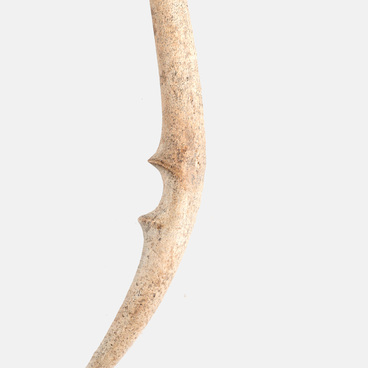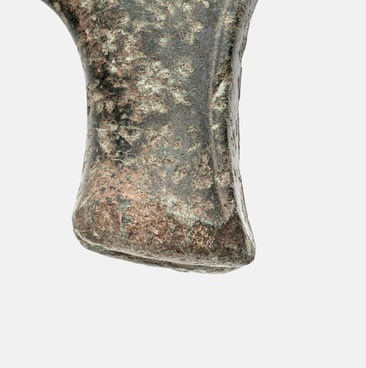The exhibition of the Chelyabinsk State Historical and Archaeological Reserve “Arkaim” presents a stone hatchet. It was found by the expedition of the Arkaim Museum-Reserve led by Tatiana Malyutina during the study of the fortified settlement of Alandskoye. The settlement is located in Kvarkensky district of Orenburg region, 6 kilometers southeast of the village of Alandskoye and 2.5 kilometers northeast of the village of Krasny Ogorodnik.
The stone ritual hatchet has a pickaxe-shaped slightly rounded blade, one of the corners is drawn downwards. The wedge is keg-shaped, round in cross-section. The flat, rounded flat cap of the butt is marked by a circular trim. On the lateral surface perpendicular to the axis of the hatchet is a rounded groove. The color of the hatchet is gray-yellow with black fine-grained inclusions. The large number of finds of stone eye axes of this type in the Southern Trans-Urals and neighboring regions can be explained only by their demand in social and religious practice.
The North Caucasus is considered the original area of borrowing, where finds of similar objects number in tens. The common features of metal production borrowed by the Sintashta metallurgists of the Southern Urals from the North Caucasus indicate the presence of stable links between the regions in the Bronze Age. The size of the axes, the diameter of the eyes, the material of manufacture and the thoroughness of surface treatment indicate the non-combat use of axes of the Kabardino-Pyatigorsk type. Besides, there is no confirmation of the thesis about such stone axes as a marker of the military status of the buried person in the burial sites of the Late Bronze Age of the Southern Trans-Urals and Northern Kazakhstan.
According to Nikolai Vinogradov, the widespread popularity of axes of the Kabardino-Pyatigorsk type among the sedentary cattle-breeding population of the Late Bronze Age on the steppes of Eastern Europe and adjacent areas of Asia was probably a consequence of the spread of the cult of the demigod — the heroic blacksmith, creator of all things Tvashtr, who gave people chariots, metallurgy and a number of crafts. Tvashtr’s son was the god of fire Agni (patron of blacksmiths and metalwork) and created a hammer for the god Indra, who was also his son. The cult of Tvashtr was widespread within the Srubnaya-Alakul culture and is reflected not only in various stone replicas of eye axes, but also in their ceramic miniature models.



